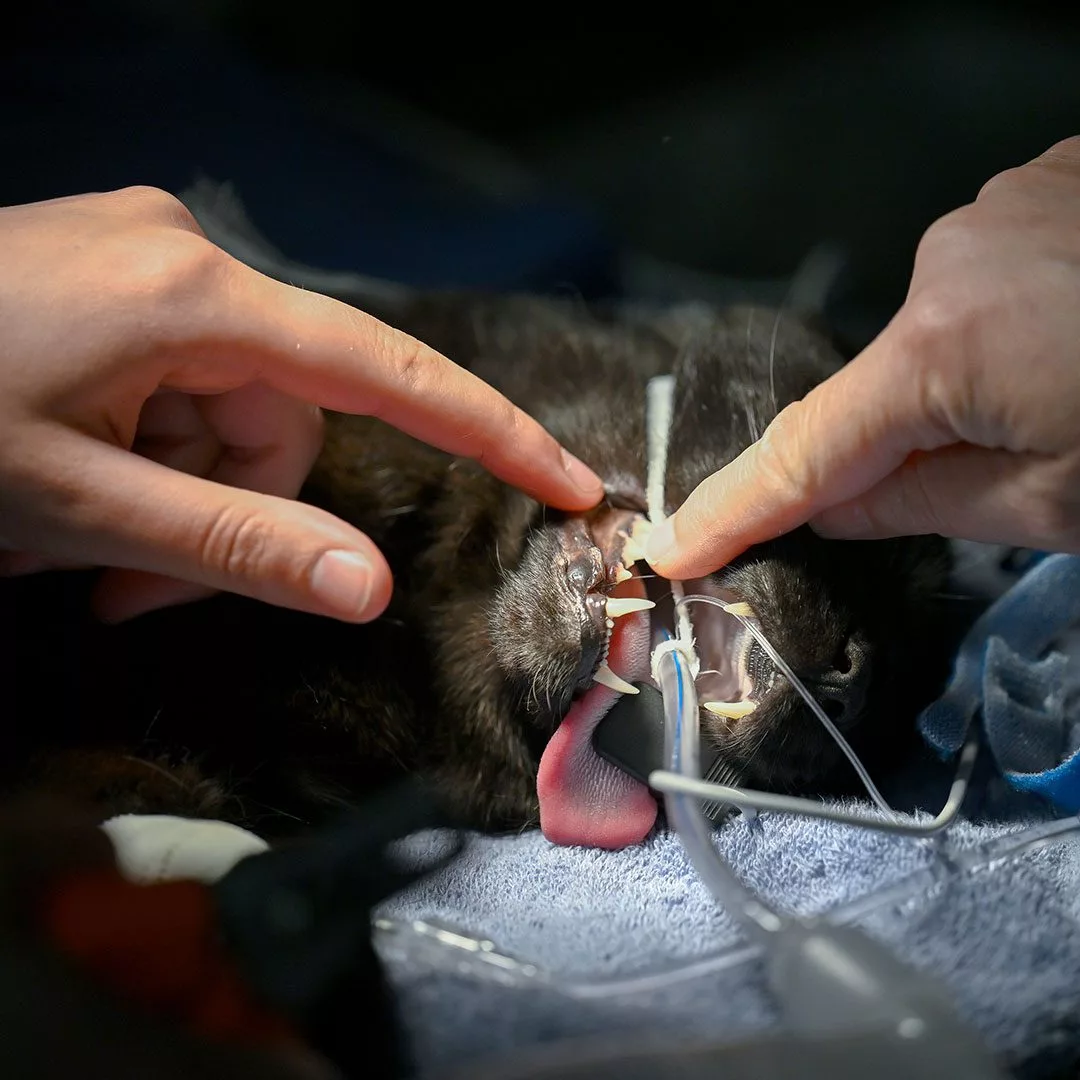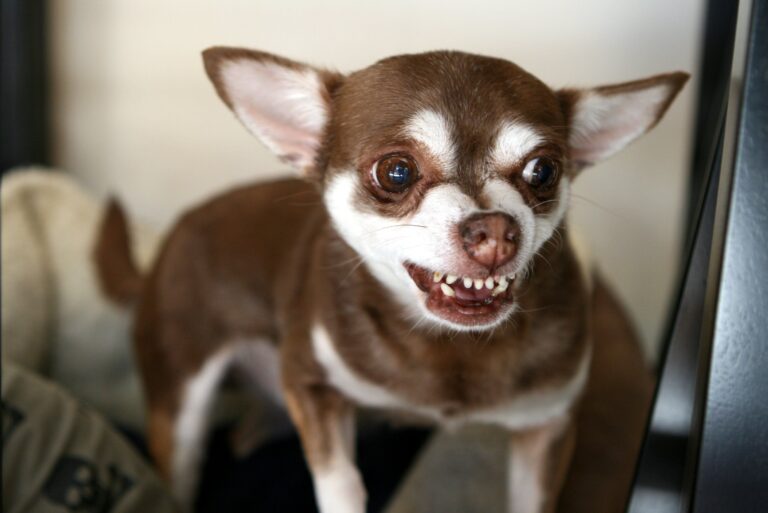The Importance of Understanding Dog Body Language
Dogs communicate primarily through body language, making it crucial for us to understand their cues to ensure a harmonious interaction. When a dog is showing teeth but not growling, it can be a sign of various emotions, including fear, anxiety, or even playfulness. Interpreting these signals accurately can prevent misunderstandings and potential conflicts.
Interpreting Teeth Display
When a dog bares its teeth without growling, it could indicate fear or discomfort. This behavior may be accompanied by other signs like a lowered posture or whale eye, where you can see the white portion of the eyes. It is essential not to misinterpret this as a sign of aggression, as the dog might be feeling threatened and is trying to communicate its unease.
Signs of Playfulness
On the other hand, dogs may also show their teeth during play as a form of a “play face.” This is often seen when dogs engage in friendly interactions, such as during a game of tug-of-war or chase. Their body language will be loose and wiggly, with a relaxed demeanor. Understanding the context of the situation is key to differentiating between fear and playfulness.

Common Misconceptions about Dogs Showing Teeth
When a dog shows its teeth but is not growling, many people immediately assume the dog is being aggressive or is about to attack. However, this is a common misconception that can lead to misunderstandings between humans and dogs.
1. Playful Behavior
One possible reason for a dog showing teeth without growling is that it may actually be a sign of playfulness. Dogs often display a “play face” where they pull back their lips and show their teeth as a way to communicate their excitement and desire to engage in play.
It is important to look at the overall body language of the dog to determine whether the teeth showing is meant in play or aggression. Loose, wiggly body movements and a relaxed posture generally indicate playfulness.
2. Submission or Fear
In some cases, a dog may show its teeth as a sign of submission or fear rather than aggression. Dogs may pull back their lips and show their teeth when feeling intimidated or anxious, as a way to communicate their discomfort or desire to avoid conflict.
It is essential to approach a dog showing teeth without growling with caution and allow them space to feel safe. Pushing a fearful dog can lead to stress and potential escalation of the situation.
Is Your Dog Fearful or Playing?
Deciphering whether your dog is displaying fear or engaging in playful behavior can sometimes be tricky, especially when your furry friend is showing teeth but not growling. It’s essential to understand the subtle cues that differentiate between fear and play to ensure the well-being and safety of your pet.
Body Language Signs of Fear
When a dog is fearful, their body language often indicates their discomfort. Some common signs of fear in dogs include:
- Dilated pupils: The dog’s pupils may appear larger than usual, indicating heightened stress levels.
- Shaking or trembling: Fearful dogs may exhibit physical trembling or shaking as a response to fear-inducing stimuli.
- Tail tucked between legs: A tucked tail can signify fear or anxiety in dogs.
Playful Behavior Indicators
On the other hand, when a dog is playing, their demeanor is typically more relaxed and carefree. Some signs that your dog is engaging in playful behavior include:
- Relaxed body posture: A dog in a playful mood usually has a loose and wiggly body language.
- Play bow: This stance involves lowering the front of the body while keeping the hind end up, signaling an invitation to play.
- Open mouth with panting: Playful dogs often have an open mouth with panting, rather than tense or closed lips.
Factors Influencing a Dog’s Behavior
Understanding a dog’s behavior can be complex, especially when they exhibit conflicting signals like showing teeth but not growling. Various factors play a role in influencing a dog’s behavior, impacting how they communicate and interact with their environment and humans.
Socialization
Proper socialization during puppyhood is crucial in shaping a dog’s behavior. Dogs that are inadequately socialized may exhibit fearful or aggressive behaviors, including teeth baring without growling.
It’s essential to expose puppies to a variety of people, animals, and environments in a positive and controlled manner to prevent fear-related responses in adulthood.
Previous Experiences
A dog’s past experiences greatly impact their behavior. Dogs that have had negative encounters or trauma may show defensive behaviors like showing teeth as a warning, even if they are not actively growling.
These dogs may display fear-based aggression due to past trauma, highlighting the importance of understanding a dog’s history and providing a secure and supportive environment.
Health and Pain
Physical health issues or pain can significantly influence a dog’s behavior. When in pain, dogs may exhibit signs of aggression, such as baring teeth, without vocalization.
Regular veterinary check-ups and monitoring for any signs of discomfort are essential to address underlying health issues that may be contributing to behavioral changes.
Effective Communication with Your Dog
When your dog is showing teeth but not growling, it is important to understand how to effectively communicate and interpret your dog’s behavior. Communication with your dog is not just verbal but also includes body language, tone of voice, and even energy levels.
Body Language Cues
Canine body language plays a crucial role in understanding your dog’s feelings and intentions. When a dog shows teeth without growling, it may indicate various emotions such as fear, playfulness, or even aggression. Observing your dog’s overall posture, facial expressions, and tail movements can provide valuable insights into their state of mind.
- Watch for subtle signs like stiffness, raised fur, or ears pinned back
- Consider the context of the situation in which the teeth are displayed
Voice Tone and Commands
In addition to body language, your voice tone and choice of commands can greatly influence how your dog responds. When addressing a situation where your dog is showing teeth without growling, it’s essential to maintain a calm and authoritative voice.
- Use clear and consistent commands to redirect your dog’s behavior
- Avoid yelling or using aggressive tones, as this may escalate the situation
Frequently Asked Questions
- What does it mean when a dog shows its teeth but not growling?
- When a dog shows its teeth without growling, it may be a sign of submission, playfulness, or fear. It’s important to consider the context and body language accompanying the gesture.
- Should I be worried if my dog shows its teeth without growling?
- Not necessarily. Dogs can show their teeth for various reasons, including communication during play or feeling anxious. Observing other signals and the overall demeanor of the dog can help in understanding the situation better.
- How can I tell if a dog is being aggressive when showing its teeth?
- Aggression is usually accompanied by other signs such as growling, stiff body language, raised fur, and a fixed stare. If you notice these additional warning signals, it’s best to proceed with caution and seek professional help if needed.
- What should I do if my dog shows its teeth in a non-threatening way?
- If your dog is showing its teeth in a non-threatening manner, it could be part of their natural behavior or a playful expression. Responding positively with praise or engaging in a playful interaction can help reinforce positive behavior.
- Can training help in deciphering my dog’s body language better?
- Yes, training can play a significant role in understanding and interpreting your dog’s body language. Working with a professional trainer can help you learn how to communicate effectively with your dog and strengthen your bond.
Unlocking the Mystery: Dog Showing Teeth But Not Growling
Understanding our furry friends can sometimes be tricky, especially when it comes to deciphering their body language like showing teeth without growling. In this blog, we’ve delved into the reasons behind this behavior, shedding light on the fact that dogs may express a range of emotions through various gestures. By recognizing the subtle cues and cues they give us, such as context, body language, and overall demeanor, we can develop a deeper connection and communicate more effectively with our canine companions.
Remember, each dog is unique, and what may work for one may not work for another. Building trust, providing a safe environment, and seeking professional help when needed are crucial steps in fostering a harmonious relationship with our beloved pets.
So next time you see your dog showing teeth without growling, approach with curiosity and empathy, and remember that they rely on us to understand them just as much as we rely on them for companionship and love.



